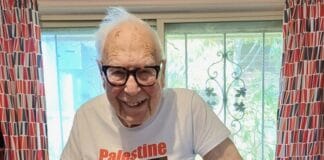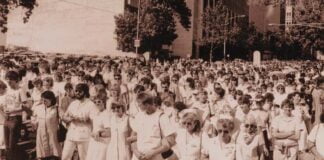The YouTube video exposing the brutal attack by NSW police on Jamie Jackson at the recent Lesbian and Gay Mardi Gras has raised question marks over so many common sense ideas about the police and about homophobia in society. It has also enraged, with a snap demonstration organised in two days attracting more than 2000 people in Sydney.
Police and some media are using a new video showing Jamie’s altercations with police beforehand to justify the violence they later used. But nothing justifies throwing a small man to the ground so hard and cracking his head against the pavement. Nor does the new footage explain why on earth police had detained Jamie in the first place. Allegedly he swore at police, an offence so widely regarded as ridiculous it is often thrown out of court. The offences he has been charged with only occurred after he was apprehended.
The attack on Jamie was not an isolated incident. Gay activist Bryn Hutchinson was also attacked by the police that night—hog-tied, kicked and stood on—for trying to cross the road. There are also reports of people being strip searched by police.
The vibrant, angry march in Sydney demanded justice for victims of violence, and that the charges against these activists will be dropped. The mass anger will have an effect in itself. As one protestor rightly commented to Solidarity, “they’ll think twice before they ever bash a gay again.”
Institutional homophobia
There is a long history of police violence against LGBT people. In fact the very first Mardi Gras in 1978 was violently attacked by police. The subsequent campaign to drop the charges against activists actually succeeded in winning the right to march in Sydney.
There can be no doubt that the victories of those activists have improved the lives of LGBT people today. Long before the law caught up with them, these activists challenged homophobia across society and made it possible for there to be any open acceptance of LGBT people.
Yet LGBT lives today are characterised by contradiction. Certainly, it is now possible in Australia to live a life outside the closet and find some acceptance. However, the very success of the LGBT movement has conservatised some elements of it. Mardi Gras is now a mainstream, and very corporate, event. Major companies compete for the “pink dollar” and for the profits that can be extracted out of LGBT venues, festivals, products, and so on. And the police, once seen as key agents of homophobic abuse, are now invited along to participate in Mardi Gras and LGBT events. Mainstream LGBT organisations confine their political activity to lobbying the powerful for piecemeal legal change, creating the impression we are just a few pieces of legislation away from true quality.
But lived experience tells us otherwise. Homophobia doggedly persists and runs much deeper than a few outmoded laws. A survey in 2005, outlined in Mapping Homophobia in Australia, reported that 35 per cent of people still think homosexuality is immoral. 61 per cent of young people report experiencing verbal abuse because of their sexuality and 18 per cent reported physical abuse in Gay and Lesbian Health Victoria’s 2011 report on same-sex attracted young people, Writing Themselves in Again. Any LGBT person can attest to their own experience of abuse, whether it be from their family, school mates, colleagues or randomly on the street.

That is because despite the gains we have made, homophobia still has a structural basis in our society—it is institutionalised within the system and in the police force particularly. It is legitimised every day by both major parties, who insist on refusing same-sex marriage despite the widespread public support for it. This encourages homophobia across society.
These politicians regularly invoke “family values” and “traditional marriage” to defend discrimination against LGBT people. They do so because the nuclear family has a particular value in a system geared towards profit. It helps generate the next generation of workers, free of any costs on the state and business. With both major parties totally oriented to pleasing business and running the system—look at how Labor appeased the mining companies—it is no surprise they want to cling to this homophobia as much as possible. They want families to bear the burden of the costs they refuse to place on business, and homophobia provides a useful justification for it.
Kevin Rudd even called the family, “the incubator of human capital”. That helps explain why Labor have been so eager to defend it in the face of popular demand for same-sex marriage. Alongside that, Labor is consumed in a race to the right with Tony Abbott for electoral advantage, and are unprepared to challenge the fringe conservative ideology of some of Abbott’s major supporters, like the Australian Christian Lobby.
Police violence
It is this status quo the police are here to “serve and protect”. No matter how many parades they are invited to march in, the role of the police remains to defend the laws of an unequal and homophobic system. It is a society in which LGBT people are still considered inferior.
The consequences of homophobia create the circumstances where LGBT people come into contact with police more often. But rather than being responsible for dealing with the causes of homophobia, police are responsible for getting people “off the streets”, charging them with petty crime, policing drinking venues, and so on. In the course of enforcing these kinds of laws, police adopt a particularly virulent hatred of the minority groups and poor people they find themselves policing.
So it should not come as a surprise that this can express itself in disregard for our lives and safety, and in disgusting acts of abuse, as it did at Mardi Gras this year. The same attitudes are visible in the police’s treatment of other minority groups—take for instance the horrific rates of Aboriginal deaths in custody, or the killing of Brazilian student Roberto Curti, who died after being tasered by police 14 times.
One estimate suggests that only 15 per cent of homophobic abuse is reported to the police. This is a sign of how people instinctively recognise that the police do not take homophobia seriously and can often be the perpetrators themselves.
The Sydney Morning Herald has recently reported on an alleged police practice of classifying gay hate homicides as suicides, death by misadventure or “unsolved” in the 1980s and 1990s. They estimate “at least 50” gay hate murders were swept under the rug in this period.
Fighting back
The early radicals who paved the way for LGBT rights today recognised the institutionalisation of homophobia. They argued that the structural roots of homophobia needed to be uprooted if society was to become truly and fully accepting of LGBT people. We can learn a lot from them.
Today, as much as in 1978, challenging homophobia means challenging the political and economic system that continues to produce it. It means throwing ourselves into struggles to change society today, whether that be marching today against the police violence, fighting for same-sex marriage, or joining the battles to free the refugees and stop the cuts to education and public services.
As the abolitionist Frederick Douglass put it, “Power concedes nothing without a demand. It never did and it never will. Find out just what a people will submit to, and you have found out the exact amount of injustice and wrong which will be imposed upon them; and these will continue till they are resisted with either words or blows, or with both. The limits of tyrants are prescribed by the endurance of those whom they oppress.”
Amy Thomas





